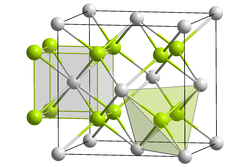Neptunium dioxide
 |
|
| Names | |
|---|---|
|
IUPAC name
Neptunium(IV) oxide
|
|
| Other names
Neptunium oxide, Neptunium dioxide
|
|
| Identifiers | |
| ECHA InfoCard | 100.031.651 |
|
PubChem CID
|
|
| Properties | |
| NpO2 | |
| Molar mass | 269 g/mol |
| Appearance | Green cubic crystals |
| Density | 11.1 g/cm3 |
| Melting point | 2,800 °C; 5,070 °F; 3,070 K |
| Structure | |
| cubic crystal system, cF12 | |
| Fm3m, #225 | |
| Np, 8, cubic O, 4, tetrahedral |
|
| Thermochemistry | |
|
Std molar
entropy (S |
19.19 ± 0.1 cal·mol−1·K−1 (80.3 ± 0.4 J·mol−1·K−1) |
|
Std enthalpy of
formation (ΔfH |
−256.7 ± 0.6 kcal·mol−1 (−1074 ± 3 kJ·mol−1) |
| Related compounds | |
|
Other anions
|
Neptunium(III) chloride Neptunium(IV) chloride |
|
Other cations
|
Uranium(VI) oxide Plutonium(IV) oxide Promethium(III) oxide |
|
Except where otherwise noted, data are given for materials in their standard state (at 25 °C [77 °F], 100 kPa).
|
|
|
|
|
| Infobox references | |
Neptunium(IV) oxide, or neptunium dioxide, is a radioactive, olive green cubic crystalline solid with the formula NpO2. It is a common product of plutonium fission, and emits both α- and γ-particles.
Industrially, neptunium dioxide is formed from the precipitation of neptunium(IV) oxalate from a neptunium feed solution with oxalic acid, followed by calcination to neptunium dioxide. The neptunium feed solution (which includes varying oxidation states of neptunium) is reduced to a predominately neptunium(IV) solution via ascorbic acid prior to the addition of oxalic acid. A hydrazine inhibitor is initially added to the neptunium feed solution to protect the neptunium and ascorbic acid from decay.
Extrapolated and balanced from "The Production of Neptunium Dioxide" by J. A. Porter
Np4+ + Np5+ + Np6+ + HNO3 + C6H8O6 → 3 Np4+ + C6H6O6 + H2 + HNO3
Np4+ + C2O4H2 → Np(C2O4) • 6H2O + 2H−
Np(C2O4) • 6H2O + Δ → Np(C2O4)
Np(C2O4) + Δ → NpO2 + 2CO2
Neptunium dioxide can also be formed effectively from precipitation of neptunium(IV) peroxide, but the oxalate reduction has been found to be more industrially efficient.
As a byproduct of nuclear waste, neptunium dioxide can be purified by fluorination, followed by reduction with excess calcium in the presence of iodine. However, the aforementioned synthesis yields a quite pure solid, with less than 0.3% weight of impurities. Generally, further purification is unnecessary.
Neptunium dioxide contributes to the α-decay of 241Am, reducing its usual half-life an untested but appreciable amount. The compound has an interestingly low specific heat capacity (900 K, compared with uranium dioxide's specific head capacity of 1400 K), an abnormality theorized to stem from its 5f electron count. Another unique trait of neptunium dioxide is its "mysterious low-temperature ordered phase". Mentioned above, it references an abnormal level of order for an actinitde dioxide complex at low temperature. Further discussion of such topics could indicate useful physical trends in the actinides.
...
Wikipedia
